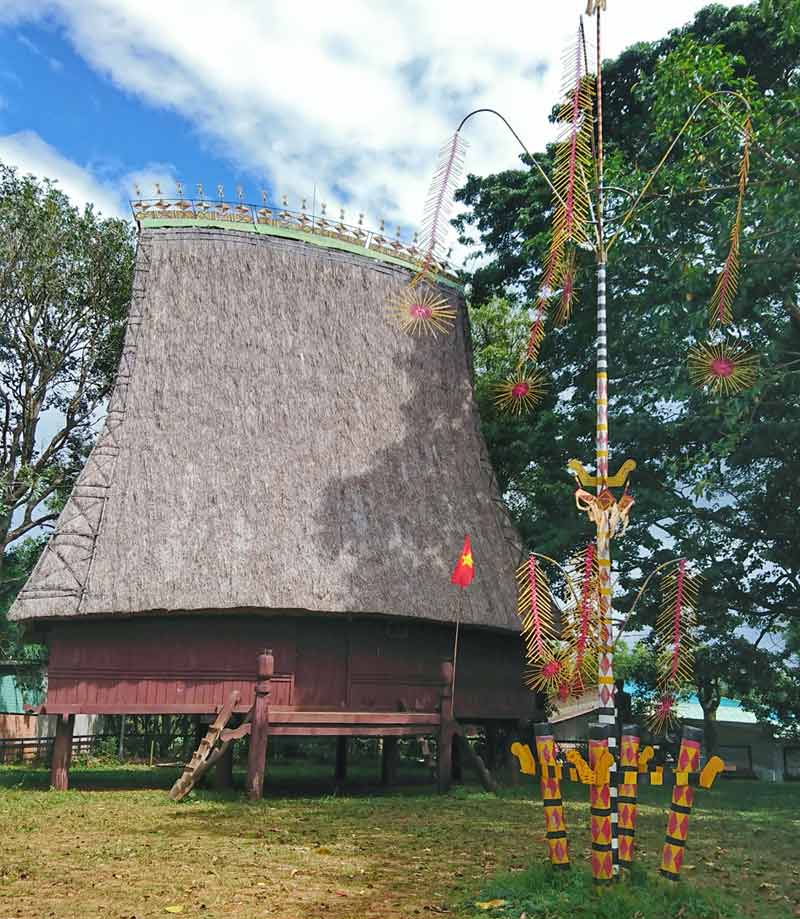
Designed as a first culture-tourism village in Pleiku City, Plei Op is a wonderful destination where visitors can explore the indigenous culture of the Gia Rai ethnic group.

The village’s gate is beautifully adorned to welcome visitors.

The communal house is the soul and symbol of village culture. Built in the shape of an axe blade, the house is made from natural materials of wood and bamboo. A bamboo pole, known in Vietnamese as ‘cay neu’, is installed in front of the house. The yard in front of the communal house is also the venue for villagers to hold festivals and gong performances.

Established in 1927, Plei Op, also known as Op Village, covers a total area of around 182 hectares in downtown Pleiku City. It is home to more than 100 households with over 500 people.

An area was set up on the left side of the yard to display wooden statues of Gia Rai and Ba Na ethnic groups. The artworks were made as the order of the city’s authorities to promote local culture and tourism.

As ethnic people only place wooden statues at the cemetery to represent the afterlife as a tribute to the death, cultural researchers and artisans had to work to change the villagers’ mindset and convince them that this was a unique folk art and cultural practice which need to be promoted to the public. The villagers are also encouraged to produce wooden statues featuring daily practices and joyful themes instead of sadness and life after death.

Those who wants to explore the traditional wooden statues can visit the cemetery, which is located at the end of the village.

The grave statues often depict people with a sad face, resting their chin on their hands, holding their head or crossing their arms.

In addition to explore culture and festivals, visitors to the village are also treated with traditional dishes made by locals.

There are three operating restaurants in Op Village, serving tourists with indigenous cuisine of Central Highlanders.

One of them is the Cong Chieng (Gong) Plei restaurant, which is decorated as a typical living space of Gia Rai ethnic people.

Many wooden statues are placed around the restaurant.

Many traditional musical instruments and labour tools are displayed inside the restaurant. At weekend, restaurant goers can enjoy traditional gong performances and folk dances delivered by the village’s art troupes.

One of the signature dishes of the restaurant is grilled chicken served with rice, which is cooked in a bamboo-tube.

Restaurant goers should not miss out on other dishes such as grilled pork skewers, indigenous vegetable, dried beef, and chicken soup cook with ‘giang’ leaves.
Source: NDO
In the last historic days of April, blending with the joyful atmosphere of the whole country, on the streets of Hoa Binh City, flags, banners and slogans are brilliantly decorated to celebrate the 50th Anniversary of Southern Liberation and National Reunification. Here are the records from Hoa Binh newspaper’s reporters:
Nestled halfway up the mountains in Cao Son commune, Da Bac district, Sung village appears like a picture preserved intact through generations. With a history of over 300 years, the village is home to nearly 100 households of Dao Tien ethnic group – the people who still maintain their distinctive characteristics in housing architecture, clothing, customs and traditional crafts. The village is drawing increasing interest and exploration from both domestic and international tourists, as every visit becomes a cultural journey to experience the authenticity, friendliness, and hospitality of this highland region.
This Spring, more than 1,000 phoenix trees in Thang Hamlet, Thach Yen Commune (Cao Phong) have bloomed brilliantly, quickly spreading on social media. The picturesque beauty of the flower garden has attracted the participation of many people to admire and take photos.
This belief is both a guiding principle and a lifelong ambition for Sa Van Cam, a member of the Tay ethnic group in Da Bac district and a passionate advocate for the Tay culture. The native has devoted years to the revival, preservation, and teaching of the ancient Tay script.
Located just 25 km from Hoa Binh city and approximately 100km from Hanoi, with a journey of around 1 hour 45 minutes, Ngoi Hoa ecotourism site (PriorBay Resort) in Suoi Hoa commune, Tan Lac district, is a stunning peninsula retreat, and a standout destination within the Hoa Binh Reservoir tourism area. Officially opening in February this year, the resort captivates visitors with its distinctive vacation products and a range of exciting adventure experiences.
Over 1,500 women paraded in traditional ao dai (long dress) at Hoa Binh Square on March 5 to mark Ao Dai Week 2025 launched by the Vietnam Women's Union. Organised by the provincial Women’s Union in collaboration with the city’s chapter, the annual event features lively folk dance performances and a colorful parade that celebrated the beauty of Vietnam’s traditional dress and its rich cultural heritage.


